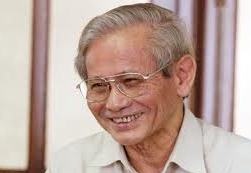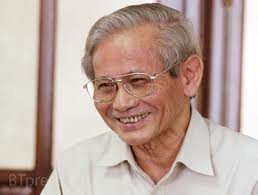
I began my career researching and teaching Vietnamese history in 1956 at the Department of History, Hanoi University (now the University of Social Sciences and Humanities, Vietnam National University, Hanoi) after graduating from the History-Geography Department of Hanoi Pedagogical University. Returning to Hanoi from the resistance zone in 1954, my classmates and I were thrilled to be able to read at the university libraries – formerly the Indochina University Library at 19 Le Thanh Tong Street and the French Far East Library (EFEO) at 26 Ly Thuong Kiet Street. During the resistance, universities lacked libraries, possessing only a few personal books passed around among professors. Therefore, reading in a spacious library filled with books related to our field was a great joy and a source of immense happiness for us. I still keep as a memento my EFEO library card, signed by Director Maurice Durand. That was my first encounter with the EFEO.

Professor Phan Huy Le (Chairman of the Vietnam Historical Science Association)
In my research on ancient Vietnamese history, the primary source of materials I accessed were the Sino-Vietnamese books concentrated at the Sino-Vietnamese Studies Department, which in 1979 became the Institute of Sino-Vietnamese Studies under the Vietnam Social Sciences Committee (now the Vietnam Academy of Social Sciences). This is the Sino-Vietnamese Archive transferred to Vietnam by the EFEO in 1957. According to the statistics of the Institute of Sino-Vietnamese Studies, this archive, with its designation beginning with the letter A, comprises 8,368 books and 20,979 rubbings of inscriptions. In this respect, I and the Vietnamese historical community are very grateful to the EFEO for their diligent collection and preservation of an important part of Vietnam's Sino-Vietnamese heritage. After 1945, due to war, weather, and even the unconscious destruction by humans, the Sino-Vietnamese heritage stored in the libraries of the Hue court, in private homes, and in village communities suffered serious losses and dispersion. Even the Long Cuong Library of Cao Xuan Duc in Thinh My (Dien Chau, Nghe An), with the great efforts of the Thanh Hoa University preparatory school in 1952, only managed to save a few hundred books out of thousands of Sino-Vietnamese texts. In the rural areas of the Red River Delta, in the past, every village had a village clerk responsible for preserving land registers, household registers, and tax records, but after the war, almost all were lost, with only a few remaining in the families of descendants of former officials. I think that without the work of the EFEO in collecting these documents, the Sino-Vietnamese heritage of Vietnam would have suffered even more severe losses, and some documents would have been permanently erased. Many of my research works and those of Vietnamese historians are based on this body of Sino-Vietnamese documents, including historical records, books, and documents such as land registers, geographical treatises, genealogies, legends, and inscriptions. Of course, today, based on the EFEO's book collections, the Institute of Sino-Vietnamese Studies and other scientific institutions have added a new body of material to this treasure trove.
Along with preserving the Han Nom heritage, the EFEO also made significant contributions to the preservation of tangible cultural heritage by documenting numerous historical and cultural relics nationwide, ranking and restoring several valuable relics in Hanoi and other provinces and cities for the first time, and building Vietnam's first museums. These include the Louis Finot Museum in Hanoi (now the Vietnam National Museum of History), the Cham Museum in Da Nang (now the Cham Sculpture Museum), and the Blanchard de la Brosse Museum in Saigon (now the Ho Chi Minh City Museum of History). These museums house not only exhibits but also valuable artifacts from Vietnamese culture and many cultures of Indochina and the Far East.
During its time operating in Vietnam from 1900 to 1959, the EFEO, through its scientific research and the journals and publications of many renowned Orientalists such as Léonard Arousseau (1888-1929), George Coedes (1886-1969), Henri Maspéro (1883-1945), Paul Pelliot (1878-1945), etc., contributed to and promoted the modernization of Vietnamese social sciences. The research and compilation of Vietnamese history in the past left a vast legacy based on the traditional perspectives and genres of East Asian civilization. The EFEO played a crucial role in creating the transition from that traditional academic foundation to a modern scientific system based on a new system of perspectives and methodologies. Along with history, new scientific disciplines emerged such as archaeology, ethnology, linguistics, museology, textual studies, etc. Historical research is conducted on a scientific foundation closely related to these disciplines, with an approach that is both specialized and multidisciplinary. In addition to French scholars, this modern research path was further developed by several Vietnamese scholars within the EFEO, such as Nguyen Van Huyen (1908-1975), Nguyen Van Khoan (1890-1975), Tran Ham Tan (1887-1957), Nguyen Van To (1889-1947), Tran Van Giap (1896-1973), etc. Several historians outside the EFEO also applied modern methodology in historical research, with Hoang Xuan Han (1908-1996) and Dao Duy Anh (1904-1988) leading the way. This was a significant step forward and a preparation for the birth and development of the socio-literature of independent Vietnam after 1945.
My generation and I entered the field of historiography based on these transformations and achievements on the path to building modern Vietnamese historiography. Vietnam is a multi-ethnic nation, comprising 54 ethnic groups belonging to 4 language families, with the Vietnamese accounting for nearly 87% of the population. Among the minority ethnic groups, three have their own writing systems: the Thai, Cham, and Khmer (the Tay and Dao use Chinese characters to transcribe their ethnic languages, similar to the Vietnamese Nôm script), and two have had their own states. Within present-day Vietnam, from ancient times, alongside the Van Lang-Au Lac kingdom, there existed the Funan kingdom in the South and the Champa kingdom in the Central region. Previously, Vietnamese history was studied and compiled based on the history of the Vietnamese people; therefore, the history of the Central and Southern regions only began when the Vietnamese began to settle and develop these lands, mainly from the 16th and 17th centuries. This effectively excludes the history of Central and Southern Vietnam before the Vietnamese colonization, and also excludes the Sa Huynh and Oc Eo cultural heritage from Vietnamese history. A new understanding has been established that considers Vietnamese history as the history of all the inhabitants, ethnic groups, and kingdoms that have ever existed on the territory of present-day Vietnam. Within this new understanding, when delving into the history of Funan and Champa, along with their rich cultural heritage, we receive the first discoveries of EFEO scholars, from research on inscriptions and related written sources in Chinese historical texts to the results of archaeological investigations and excavations of the Oc Eo and Sa Huynh cultures and the temple and tower relics scattered across the Central region. Once again, we encounter the research achievements of the EFEO, which serve as a foundation for Vietnamese archaeologists and historians to develop many new findings.
After a period of interruption, from 1959 to 1992, EFEO returned to Vietnam in 1993 with the establishment of the EFEO center in Hanoi. The cooperative relationship between the two sides was established on the new foundation of two independent nations. I am very pleased with the results of the Center's activities and the successes in its research projects in cooperation with Vietnamese research institutes and universities. I particularly appreciate the published works on the fund's documentation system, such as...Anthology of other Hán Nôm texts/Corpus des inscriptions anciennes du VietnamIt consists of 24 episodes.Dong Khanh Geographical Gazetteer/Descriptive Géographie de l'Empereur Dong Khanh3 episodes,Techniques of the Annamite peopleHenri Auger's work consists of 3 volumes.
For over half a century, through two periods of operation in Vietnam, with its headquarters in Hanoi, the EFEO, with its renowned authors and specific scientific works, has made a significant contribution to the study of Vietnamese history and culture from many different perspectives. During that time, the EFEO also made important contributions to the preservation of Vietnamese cultural heritage and the modernization of Vietnamese historiography and social sciences in general. As a historian who has had many opportunities to interact with the EFEO in Hanoi and Paris, I welcome the EFEO's contributions to Vietnam and congratulate Professor Yves Goudineau, Director of the EFEO, and Professor Léon Vendermersch, Director of the EFEO from 1989-1993, who played a major role in re-establishing the EFEO Center in Vietnam.
* Article title created by the ussh.edu.vn Editorial Board.
Author:Professor Phan Huy Le
Newer news
Older news